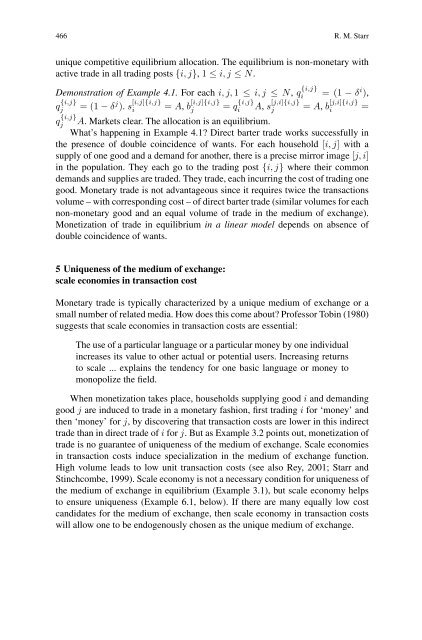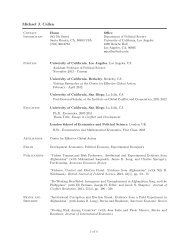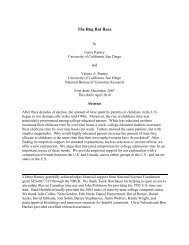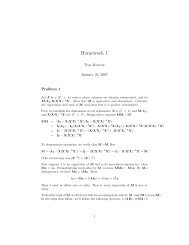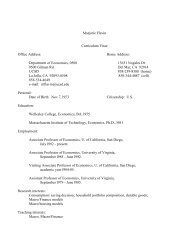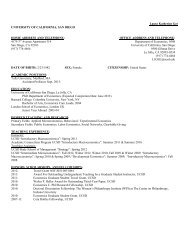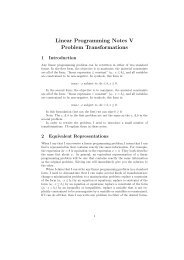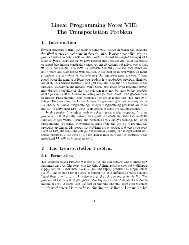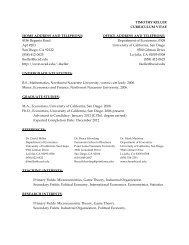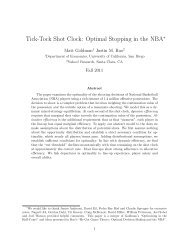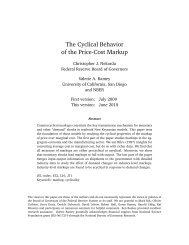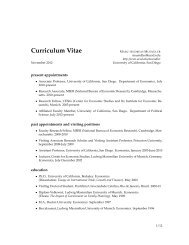Endogenous derivation of 'money' - UC San Diego Department of ...
Endogenous derivation of 'money' - UC San Diego Department of ...
Endogenous derivation of 'money' - UC San Diego Department of ...
Create successful ePaper yourself
Turn your PDF publications into a flip-book with our unique Google optimized e-Paper software.
466 R. M. Starr<br />
unique competitive equilibrium allocation. The equilibrium is non-monetary with<br />
active trade in all trading posts {i, j}, 1 ≤ i, j ≤ N.<br />
Demonstration <strong>of</strong> Example 4.1. For each i, j, 1 ≤ i, j ≤ N, q {i,j}<br />
i<br />
= A, b [j,i]{i,j}<br />
i<br />
=(1−δi ),<br />
q {i,j}<br />
j =(1−δj ). s [i,j]{i,j}<br />
i = A, b [i,j]{i,j}<br />
j = q {i,j}<br />
i A, s [j,i]{i,j}<br />
j<br />
=<br />
q {i,j}<br />
j A. Markets clear. The allocation is an equilibrium.<br />
What’s happening in Example 4.1? Direct barter trade works successfully in<br />
the presence <strong>of</strong> double coincidence <strong>of</strong> wants. For each household [i, j] with a<br />
supply <strong>of</strong> one good and a demand for another, there is a precise mirror image [j, i]<br />
in the population. They each go to the trading post {i, j} where their common<br />
demands and supplies are traded. They trade, each incurring the cost <strong>of</strong> trading one<br />
good. Monetary trade is not advantageous since it requires twice the transactions<br />
volume – with corresponding cost – <strong>of</strong> direct barter trade (similar volumes for each<br />
non-monetary good and an equal volume <strong>of</strong> trade in the medium <strong>of</strong> exchange).<br />
Monetization <strong>of</strong> trade in equilibrium in a linear model depends on absence <strong>of</strong><br />
double coincidence <strong>of</strong> wants.<br />
5 Uniqueness <strong>of</strong> the medium <strong>of</strong> exchange:<br />
scale economies in transaction cost<br />
Monetary trade is typically characterized by a unique medium <strong>of</strong> exchange or a<br />
small number <strong>of</strong> related media. How does this come about? Pr<strong>of</strong>essor Tobin (1980)<br />
suggests that scale economies in transaction costs are essential:<br />
The use <strong>of</strong> a particular language or a particular money by one individual<br />
increases its value to other actual or potential users. Increasing returns<br />
to scale ... explains the tendency for one basic language or money to<br />
monopolize the field.<br />
When monetization takes place, households supplying good i and demanding<br />
good j are induced to trade in a monetary fashion, first trading i for ‘money’ and<br />
then ‘money’ for j, by discovering that transaction costs are lower in this indirect<br />
trade than in direct trade <strong>of</strong> i for j. But as Example 3.2 points out, monetization <strong>of</strong><br />
trade is no guarantee <strong>of</strong> uniqueness <strong>of</strong> the medium <strong>of</strong> exchange. Scale economies<br />
in transaction costs induce specialization in the medium <strong>of</strong> exchange function.<br />
High volume leads to low unit transaction costs (see also Rey, 2001; Starr and<br />
Stinchcombe, 1999). Scale economy is not a necessary condition for uniqueness <strong>of</strong><br />
the medium <strong>of</strong> exchange in equilibrium (Example 3.1), but scale economy helps<br />
to ensure uniqueness (Example 6.1, below). If there are many equally low cost<br />
candidates for the medium <strong>of</strong> exchange, then scale economy in transaction costs<br />
will allow one to be endogenously chosen as the unique medium <strong>of</strong> exchange.


